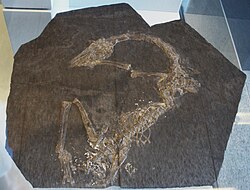Macrocnemus bassanii
|
Macrocnemus Temporal range: Middle Triassic, 245–228 Ma |
|
|---|---|
 |
|
| Fossil of Macrocnemus bassanii | |
| Scientific classification | |
| Kingdom: | Animalia |
| Phylum: | Chordata |
| Class: | Reptilia |
| Clade: | Archosauromorpha |
| Order: | †Protorosauria |
| Genus: |
†Macrocnemus Nopcsa, 1931 |
| Species | |
|
|
Macrocnemus is an extinct genus of archosauromorph reptile from the Middle Triassic of Europe and China.
The name is from the Greek for "long tibia". The genus Macrocnemus is classified as a Prolacertiformes or Protorosaurus, which has three species. The most abundant species is the Macrocnemus bassanii had many species that ranged in different sizes of morphology and they seem to be 220 myrs old during the Middle Triassic. The size of this species ranged from 20 to 100 centimeters long. The Macrocnemus is believed to be a sister to Huehuecuetzpalli, which is a basal lizard. Also the smallest and most primitive of the Macrocnemus is BES SC 111. Macrocnemus (Reptilia- diapsid) also known as Macrocnemus is part of the Tanystropheidae family and have three subtaxa, which include Macrocnemus bassanii, Macrocnemus fuyuanensis and Macrocnemus obristi. Discovered in the Southern Alps from the Besano formation comes a protorosaur Macrocnemus. Nopcsa was the first to describe the Macrocnemus based off perseveres of the species that came from Museo Civico di Storia Naturale in Milano. The first species that was named and discovered was the M. bassanii. All the way back to the Middle Triassic of Southern China is a second species of M. fuyuanesis that was discovered,. Then the new species is similar to the one found in Europe and the Chinese diagnosed its characteristics due to the formation of the forelimb. The recently discovered new species of Macrocnemus is the M. obristi, the main features of this species that set it apart from others is that tibia is longer than the femur and it has gracile limbs. The original distal caudal series of the Macrocnemus possesses at least 52 or 53 caudal vertebrae because the newly discovered species M. obristi has it present. Macrornemus is pretty well studied taxa, therefore there is enough evidence to understand the anatomy of the postcranial skeleton. Within the tarsus of the Macrocnemus includes astragalus, calcaneum, a centrale and the distal tarsals 4, 3, 1. A conclusion of based of the appendicular structure of the skeleton implies terrestrial habitats and rapid bipedal movement.
The most primitive M. bassinii, BES SC 111, is believed to arboreal. Its lengthy tendril-like extremities advise experts to conclude that it was a fast climber. There is a trend that favors towards the pelvis anchors to rotate due to the reduction of the caudoferoral retarctor anchors, then the hind limbs to retract. The most prominent feature that distinguishes the Macrocnemus from the Huehuecuetzpalli, is the shorten pedal five digit. What’s odd about that is that nested descendants of Macrocnemus seemed to retain or regain that shorten pedal five digit. This study is further being researched due to insufficient data.
...
Wikipedia
